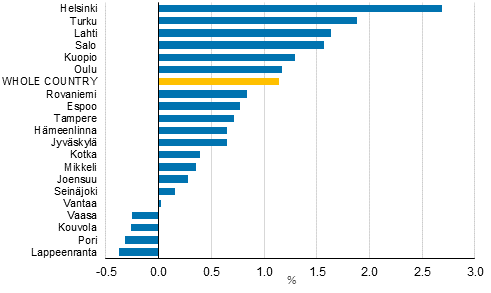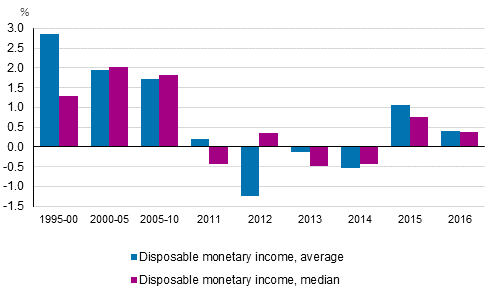This set of statistics has been discontinued.
Statistical data on this topic are published in connection with another set of statistics.
Data published after 5 April 2022 can be found on the renewed website.
Published: 20 December 2017
Household-dwelling units’ income has increased most in Helsinki in recent years
In 2016, the median income of household-dwelling units in the whole country was in real terms 1.1 per cent higher than two years previously, whereby the income development of household-dwelling units made an upturn after many years without growth. Of the largest towns, the income of household-dwelling units has increased most in Helsinki, where the median income was 2.7 per cent higher last year than in 2014. Over the same period, the income of household-dwelling units in Turku grew by 1.9 per cent, in Lahti and Salo a couple of tenths less. The data are based on the regional data of Statistics Finland’s Total statistics on income distribution.
Changes (%) in real income of household-dwelling units in 2014 to 2016, 20 municipalities with the largest population

The income concept disposable monetary income per consumption unit, median
Of big towns, the income development was weakest in Lappeenranta, Pori, Kouvola and Vaasa, where the income of household-dwelling units has decreased over the past few years by a couple of tenths of a per cent.
The median for the disposable monetary income of household-dwelling units was EUR 31,820 in the whole country in 2016. Of municipalities with the largest population, the income of household-dwelling units in Espoo was clearly highest, EUR 41,650. In Vantaa, the median income of household-dwelling units was EUR 35,890 last year. In household-dwelling units of Helsinki, the biggest municipality in the country, this income was EUR 32,720.
With respect to all municipalities, household-dwelling units had by far the highest income in Kauniainen, where the median income of household-dwelling units was EUR 58,820 last year. In addition to Kauniainen, the income level of household-dwelling units in Åland’s Jomala exceeded EUR 50,000 (EUR 50,210). Household-dwelling units in Rääkkylä in North Karelia and in Rautavaara in Pohjois-Savo had the lowest income, there the median income of household-dwelling units was below EUR 25,000 last year. Income data with different concepts for all municipalities are found in the database tables of Total statistics on income distribution.
Growth in Finnish households’ real income slowed down in 2016
In the early 2010s, the income development of Finnish households has long been weak, in some years, the disposable monetary income of household-dwelling units even decreased in real terms. In 2015, household-dwelling units’ income development turned clearly positive after a long time, but in 2016, the growth rate of real income slowed down, however. The growth rate of household dwelling-units’ real income was last year, measured both by average and median income, close on half a per cent, while one year earlier, it was around one per cent with both indicators.
Annual changes in household dwelling-units’ real income in 1995 to 2016

Income change in 1995 to 2000, 2000 to 2005 and 2005 to 2010 describes the average annual change in the period
Source: Total statistics on income distribution, Statistics Finland
Inquiries: Pekka Ruotsalainen 029 551 2610
Director in charge: Jari Tarkoma
- Tables
-
Tables in databases
Pick the data you need into tables, view the data as graphs, or download the data for your use.
Updated 20.12.2017
Official Statistics of Finland (OSF):
Total statistics on income distribution [e-publication].
Income development by area 2016. Helsinki: Statistics Finland [referred: 24.12.2025].
Access method: http://stat.fi/til/tjkt/2016/02/tjkt_2016_02_2017-12-20_tie_002_en.html

